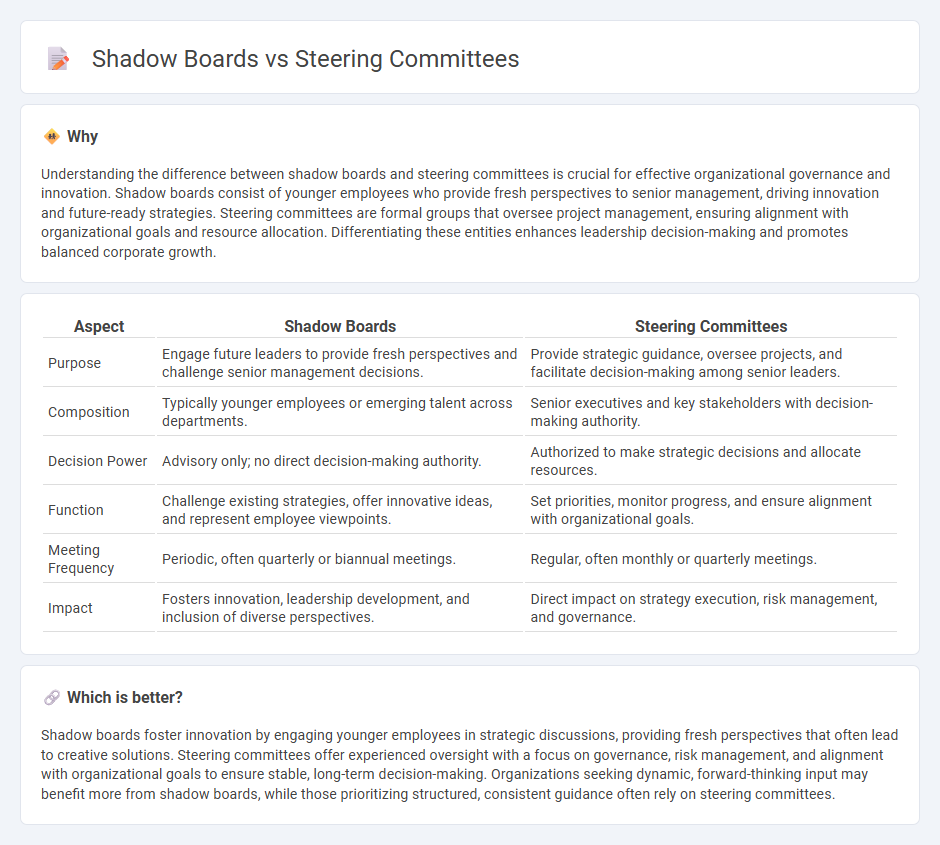
Shadow boards foster innovation by including younger employees in strategic decision-making, offering fresh perspectives that traditional structures may overlook. Steering committees provide oversight and guidance by assembling senior leaders who align company objectives with operational execution. Discover how these governance models impact organizational agility and leadership effectiveness.
Why it is important
Understanding the difference between shadow boards and steering committees is crucial for effective organizational governance and innovation. Shadow boards consist of younger employees who provide fresh perspectives to senior management, driving innovation and future-ready strategies. Steering committees are formal groups that oversee project management, ensuring alignment with organizational goals and resource allocation. Differentiating these entities enhances leadership decision-making and promotes balanced corporate growth.
Comparison Table
| Aspect | Shadow Boards | Steering Committees |
|---|---|---|
| Purpose | Engage future leaders to provide fresh perspectives and challenge senior management decisions. | Provide strategic guidance, oversee projects, and facilitate decision-making among senior leaders. |
| Composition | Typically younger employees or emerging talent across departments. | Senior executives and key stakeholders with decision-making authority. |
| Decision Power | Advisory only; no direct decision-making authority. | Authorized to make strategic decisions and allocate resources. |
| Function | Challenge existing strategies, offer innovative ideas, and represent employee viewpoints. | Set priorities, monitor progress, and ensure alignment with organizational goals. |
| Meeting Frequency | Periodic, often quarterly or biannual meetings. | Regular, often monthly or quarterly meetings. |
| Impact | Fosters innovation, leadership development, and inclusion of diverse perspectives. | Direct impact on strategy execution, risk management, and governance. |
Which is better?
Shadow boards foster innovation by engaging younger employees in strategic discussions, providing fresh perspectives that often lead to creative solutions. Steering committees offer experienced oversight with a focus on governance, risk management, and alignment with organizational goals to ensure stable, long-term decision-making. Organizations seeking dynamic, forward-thinking input may benefit more from shadow boards, while those prioritizing structured, consistent guidance often rely on steering committees.
Connection
Shadow boards and steering committees both play critical roles in organizational governance by advising executive leadership and driving strategic initiatives. Shadow boards provide diverse, often younger perspectives to challenge existing management decisions, while steering committees oversee project execution and resource allocation to ensure alignment with company objectives. Their connection lies in fostering collaborative decision-making processes that enhance innovation and effective strategy implementation within management frameworks.
Key Terms
Governance
Steering committees consist of senior leaders guiding project decisions and ensuring alignment with organizational goals, while shadow boards comprise emerging talent offering fresh perspectives on governance and strategy. Shadow boards enhance agility by incorporating diverse viewpoints, whereas steering committees provide stability through experienced oversight. Explore the nuances of effective governance models to optimize your organization's strategic direction.
Decision-making
Steering committees typically consist of key stakeholders who guide project direction and ensure alignment with organizational goals through formal decision-making processes. Shadow boards, composed mainly of younger or emerging leaders, provide fresh perspectives and innovative insights to influence strategic decisions indirectly. Explore the distinct roles and benefits of steering committees and shadow boards to enhance your organization's decision-making framework.
Innovation
Steering committees guide organizational strategy through established governance structures, ensuring alignment with company objectives and risk management. Shadow boards, composed of emerging leaders, stimulate innovation by offering fresh perspectives and challenging conventional thinking. Discover how integrating both can drive dynamic innovation in your organization.
Source and External Links
What's a Steering Committee, and Should You Create One? - This article explains that a steering committee is an advisory board that guides organizations or projects by making high-level decisions and setting strategic directions.
Steering Committee: Definition, Challenges & Best Practices - This page discusses the role of steering committees in guiding projects from start to finish, overseeing budget and timelines, and ensuring project success.
What is a Steering Committee? (Overview, Roles, and Responsibilities) - This article provides an overview of steering committees, detailing their roles in offering advice, setting timelines and budgets, monitoring quality, evaluating risks, and defining project outcomes.
 dowidth.com
dowidth.com